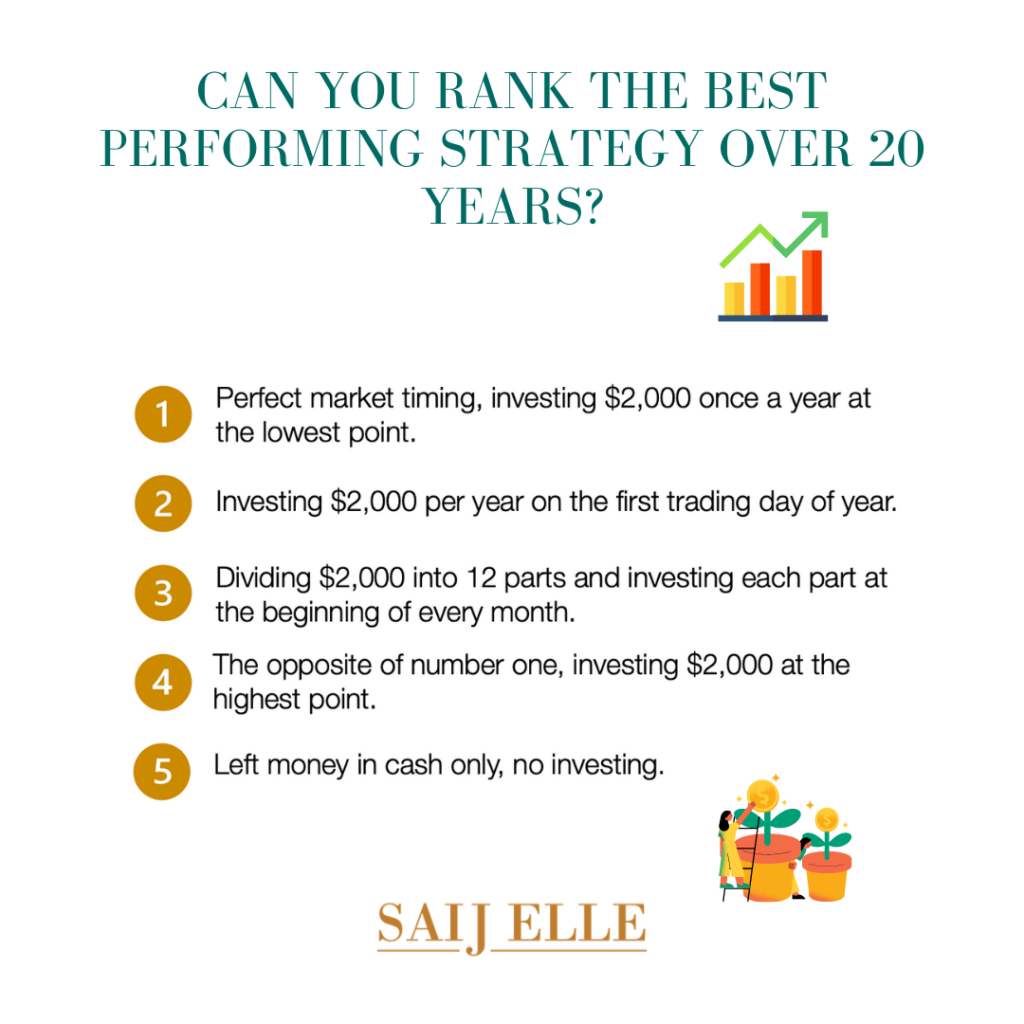At the time of writing this, most stock markets around the globe have taken a major hit due to fear of higher interest rates, higher inflation, and a looming recession.
But as inflation concerns begin to ease, many women are writing me to ask whether now is the time to buy stocks and if so, how they should go about doing it.
Here’s my advice on when is the best time to buy stocks:
1. Recognize that you can’t time the market
Seriously. No one can.
There are thousands of factors that can determine the stock market’s direction. That’s not to say there aren’t “signs” that indicate the worst is over or yet to come, but all it takes is a major geopolitical event and these predictions go right out the door.
So stop trying to time the market.
The most successful investors such as Warren Buffett and Peter Lynch have shunned the concept of market timing so if they do it, why would you think you can do better?
The real fortunes in this country have been made by people who have been right about the business they invested in, and not about the timing of the stock market. – Warren Buffett
There have been several studies done on the impact of trying to time the market.
~ Take a look at the image below ~
This study looked at the best-performing strategy over 20 years and then ranked the performance

Strategy 1: Assumed the investor could time the markets perfectly by investing $2,000 at the lowest point every year for 20 years.
Strategy 2: Assumed they simply invested $2,000 at the beginning of the first trading day each year (January x) for 20 years.
Strategy 3: Assumed the investor divided $2,000 equally by 12 and invested each part at the beginning of every month.
Strategy 4: Assumed they invested $2,000 at the highest point every year.
Strategy 5: Assumed the investor kept $2,000 (x 20) in cash and didn’t invest at all.
Could you rank each investment strategy in order from best to worst returns?
I’ll save you the hassle.
It is this exact order.
So Strategy 1 performed the best, and Strategy 5 performed the worst.
If you could time the market perfectly like in Strategy 1, you’d have superior returns, except it’s difficult to do it one time and impossible to do year after year for 20 years! There wasn’t a big difference in returns between Strategy 2 and Strategy 3 either, which surprised many.
So what’s the lesson?
- Invest, because leaving your money in cash is less than ideal.
- And, it doesn’t matter if you invest a lump sum like in Strategy 2 or use the dollar-cost-average strategy which is Strategy 3 – the performance differential is negligible.
Far more money has been lost by investors preparing for corrections, or trying to anticipate corrections, than has been lost in corrections themselves. – Peter Lynch
2. Recognize that different types of stocks react differently to economic cycles
If you’re looking for good buying opportunities when the market is well above historical (price-to-earnings) valuations, it might be hard to find a stock that will provide a lot more upside – at least in the short term.
There’s a difference between a well-run company and a good stock. If the price of its stock compared to its underlying fundamentals is too high, the gains could be limited. When there is a correction, these types of stocks are seen to be “overvalued” and the ones that investors take profits in first.
We saw this with many of the big tech darlings this past year such as Tesla, Apple, and Amazon.
On the other hand, after a broad market decline, you’re far more likely to find undervalued shares that will provide more upside. Do your research and find out what analysts are saying.
3. Pay attention to cyclical stocks
Cyclical stocks rise and fall with the economy and are affected by macroeconomic cycles (i.e., expansions, peaks, recessions, and recovery).
Many cyclical stocks are companies that depend on consumer spending patterns. Examples include high-end restaurants, car manufacturers, airlines, clothing retailers, and advertising companies. That’s because when the economy is recovering or doing well, people feel more confident and are willing to shop, travel or buy new cars. That translates into higher profits for these companies and rising stock prices.
If economic indicators suggest the worst of a recession is nearly over, this could be an opportunity to beef up your portfolio with select cyclical stocks or a mutual fund/ETF.
To learn more about different stocks, watch this VIDEO.
4. Recognize that investing in stocks is primarily a long-term game
Investing in equities and risky asset classes should be reserved for long-term goals such as retirement that are five years or more away.
The reason is if you need the funds in a year or two, and the stock drops in price, you could be forced to sell it at a loss. When you invest with a long-term view, even if the stock falls, there’s a good chance it will recover.
In conclusion, there isn’t a “perfect” time to buy stocks, so stop stressing over it. It is more important to be in the market and stay consistent with your purchasing strategy. If you’re going to pick individual stocks, do your homework. And don’t forget to diversify your portfolio with a variety of different investments. Mutual funds and exchange-traded funds are great options for this, especially if you don’t have a lot of money or time to manage your portfolio.
Do you want to start investing and still nervous? Check out my Get Investing course.
It’s a three-lesson course that comes with easy-to-understand instruction videos and worksheets. Plus, when you join, you’ll have access to my private online community where you can ask me questions!

